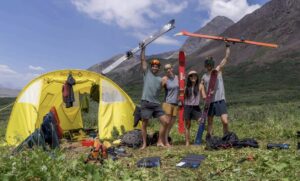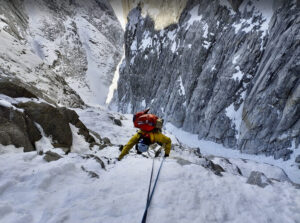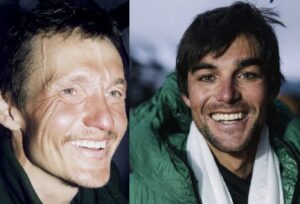Little by little, Himalayan teams are returning home. Some reached their summits, others left empty-handed. But success is not just about the summit, especially for alpine-style attempts, and there have been many of them in Nepal this season.
One team per 8,000’er
The team who attempted Makalu in alpine style — they were completely alone on the mountain — is on its way back to Kathmandu.
“So far I know from my base camp staff, they did not succeed,” Moham Lamsal of Makalu Adventure told Explorersweb. The climbers are Matthew Scholes and Matthew Clark from Australia, and Alastair McDowell and Hamish Fleming of New Zealand.

The headwall high on Cho Oyu’s south side. Photo: Andrei Vasiliev/RAF
Dhaulagiri is also deserted after the tragic end of the Russian expedition, where Nadya Oleneva perished in a fall. Action on the 8,000’ers is now reduced to a second Russian team, currently progressing on the South Face of Cho Oyu. According to their latest report, they are working on the crux of the climb: the headwall leading to the summit plateau.
The Russians are climbing in classic Himalayan style, but without oxygen or sherpas, on a new route up the highly difficult South Face of the 8,188m peak.
Alpine-style teams
The Japanese team of Takahiro Kaneko, Saki Terada, and Takahiro Ishikawa launched their summit push on 6,076m Sharpu VI yesterday, but retreated at 5,670m when they confronted an impassable section of loose scree covered in soft, unstable snow, Himalaya Camp reported. They have returned to Base Camp. It is unclear whether they will launch a second summit attempt or not.

The Japanese team attempting Sharpu VI: Takahiro Kaneko, Saki Terada, and Takahiro Ishikawa. Photo: Akahiro Kaneko/Instagram
Another Japanese team, this one from Meiji University and led by Kazuaki Amano, are attempting the first ascent of Anidesh Chuli, a nearly 7,000m peak in the Kangchenjunga area. At last word, they were ready for a summit push but there has been no news from them for two weeks.
Simone Moro retreated 100 meters below the summit of Pumori some weeks ago. Nor did he climb Lingtren with Spanish free-rider Aymar Navarro, as originally planned.
Summiting is not the norm
In the last few days, we’ve had excellent news about the U.S. team that finally achieved the first alpine-style ascent of the north face of Jannu, and also from Russian Piolet d’Or winners Yuri Koshelenko and Alexei Lonchinsky. They completed the southeast buttress of Rolwaling Kang Shar yesterday.
Americans Sam Hennessey and Michael Gardner, who shared permits for Jannu with the successful trio who climbed the north face, are back in civilization, apparently without summiting but grateful for the experience.
Alpine-style teams know that their chances of succeeding on a difficult goal are slim compared to the crazy summit rates of guided, highly supported expeditions. Failure is normal on technical, difficult mountains. The real goal is to make it down safely. Exceptional successes like Jannu and Rolwaling Kang Shar are reasons to celebrate.
This autumn, more teams than usual took on the challenge of lonely peaks, most of them on new routes. According to the latest (Oct. 20) update, Nepal’s Department of Tourism issued 36 permits for small teams on 6,000m and 7,000m peaks. This does not include Ama Dablam or trekking peaks such as Himlung.
On the 8,000’ers, most teams concentrated on Manaslu, and a few headed to Dhaulagiri. Makalu only had the Australian-New Zealand team, while the lone Russian team continues to work on the difficult Nepal side of Cho Oyu.
No winter expeditions so far
November is traditionally the time for trekkers in Nepal. Only Ama Dablam is open until December. If the post-pandemic trend continues, the biggest outfitters may leave their Ama Dablam camps open for eventual winter climbers.
So far, no winter expeditions have been announced. An injured Jost Kobusch of Germany has had to cancel his plans for Everest West Ridge because of a hip issue sustained during training. Yet no word does not necessarily mean no climbing. In recent years, many winter expeditions have announced their plans mere days before leaving.






